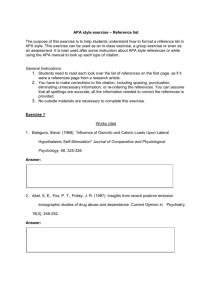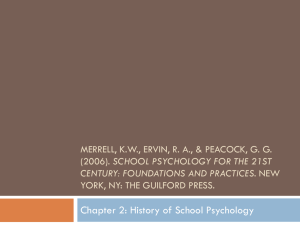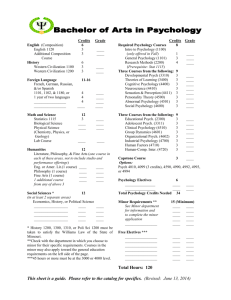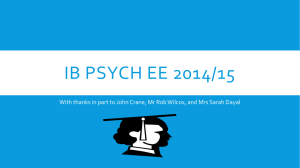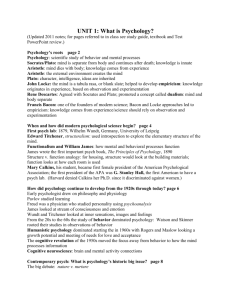Proposal
advertisement
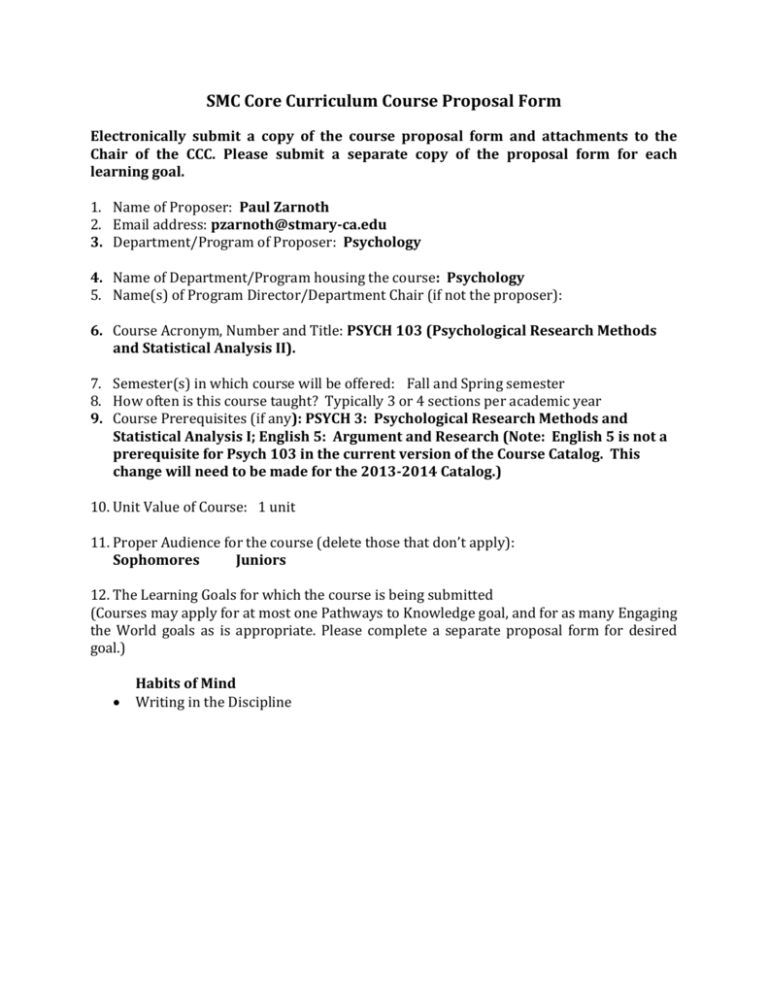
SMC Core Curriculum Course Proposal Form Electronically submit a copy of the course proposal form and attachments to the Chair of the CCC. Please submit a separate copy of the proposal form for each learning goal. 1. Name of Proposer: Paul Zarnoth 2. Email address: pzarnoth@stmary-ca.edu 3. Department/Program of Proposer: Psychology 4. Name of Department/Program housing the course: Psychology 5. Name(s) of Program Director/Department Chair (if not the proposer): 6. Course Acronym, Number and Title: PSYCH 103 (Psychological Research Methods and Statistical Analysis II). 7. Semester(s) in which course will be offered: Fall and Spring semester 8. How often is this course taught? Typically 3 or 4 sections per academic year 9. Course Prerequisites (if any): PSYCH 3: Psychological Research Methods and Statistical Analysis I; English 5: Argument and Research (Note: English 5 is not a prerequisite for Psych 103 in the current version of the Course Catalog. This change will need to be made for the 2013-2014 Catalog.) 10. Unit Value of Course: 1 unit 11. Proper Audience for the course (delete those that don’t apply): Sophomores Juniors 12. The Learning Goals for which the course is being submitted (Courses may apply for at most one Pathways to Knowledge goal, and for as many Engaging the World goals as is appropriate. Please complete a separate proposal form for desired goal.) Habits of Mind Writing in the Discipline Expected Attachments (1) Syllabus: Course syllabus containing a course description and a list of learning outcomes. The course’s learning outcomes should include coverage of the Learning Outcomes associated with the Core Curriculum Learning Goal for which the course is being proposed. The syllabus for Psychology 103 is included. Students in psychology will complete the Writing in the Discipline sequence by taking this course. Note, however, that writing in the discipline is actually taught across a two-course sequence in Psychology, beginning with Psychology 3. (2) Teaching and Learning: Learning Outcomes Related to Written Communication: 1. Students will compose clear and carefully organized prose using APA style. 2. Students will recognize and formulate effective written communication, giving appropriate consideration to audience, context and format. 3. Students will construct well-reasoned arguments, supported by theory and past research, in the development of research hypotheses. 4. Students will use the process of writing (including brainstorming, collaboration, outlining, drafting, and revising) to enhance intellectual discovery and unravel complexities of thought. Learning Outcomes Related to Information Evaluation and Research Practices: 1. Students will use PsychINFO to find theory and research relevant to an area of interest. 2. Students will critically evaluate sources. 3. Students will integrate and cite evidence following the rules of APA style. 4. Students will understand the concept of intellectual property and practice academic honesty. Student attainment of the learning outcomes will be achieved and evaluated through a series of scaffolded projects over the two semester sequence (Psychology 3 and Psychology 103). To explain the process, each of the fifteen projects will be described in turn. The projects begin small and grow in complexity over the two semesters. Psych 3, Project 1: Prior to beginning project 1, the class visits the library, and a librarian (to date, always Patty Wade) delivers an hour-long presentation on effective search strategies using PsychInfo (IERP learning outcome #1). The librarian also begins the process of helping the students to understand how to critically evaluate sources. For example, she distinguishes between primary and secondary sources, between academic journal articles and popular press articles, between dissertations and other sources, etc. The students then complete project 1. This project asks them to locate a primary source article within an academic journal and then to use PsychInfo to search for additional articles that are closely related to the topic of the first. Psych 3, Project 2: Students receive one of a set of short articles taken from the popular press. Each describes psychological research. Students are asked to identify critical pieces of information including the research question, the selection process used to gather participants, the general type of research (experimental vs. non-experimental), the variables and their operational definitions, and the conclusions that were reached (IERP outcome #2). Students are then asked to identify any logical errors in the conclusions that were presented in the article (IERP outcome #2). Finally, students are asked to evaluate how well the research was reported, with special attention given to information that was missing or difficult to understand (Written Communication learning outcome #2; IERP outcome #2). Student responses are typically about 3 pages in length, double-spaced. Psych 3, Project 3: This project builds directly upon the knowledge and skills developed in project 2. In fact, the project description is nearly identical to that used in project 2. However, in project 3, students choose from a set of research articles taken from professional journals. In addition to answering the questions presented in project 2, students are also asked to directly compare how the research was reported in the article that they received for project 2 and the article that they chose for project 3. (WC #2; IERP #2) Student papers are typically about 5 pages in length. If students choose, they are permitted to work collaboratively with another student on this project. Psych 3; Project 4: Students develop a research question that can be analyzed using basic descriptive statistics (e.g., central tendency & variability). Students then collect a small data set, use SPSS to analyze their data and create a figure, and report their results in a brief report. The primary goal of this project is to give students experience analyzing data. However, students are asked to write an extremely short results section that uses APA format. (WC #1 & 2) Psych 3; Project 4: Students develop a research question that can be answered using the methodology of naturalistic observation and basic descriptive statistics. Students carry out a carefully designed observational study and analyze their data with exactly the same set of analyses used in project 3. Students write a relatively short APA style research report including a title page, simple introduction, method section, results section and discussion. Students are not asked to consider past research for the purpose of this project. Therefore, the students’ hypotheses are expected to be developed with simple well-reasoned arguments rather than built upon past theory and research evidence. The report is not expected to include an abstract or a reference section. Because students are required to include a measure of inter-rater reliability, they are also required to work with one or more partners on this project. Each student analyses his or her own individual data and turns in his or her own paper. However, students are invited to work together on some sections of the paper. (WC # 1, 2, & 3) Psych 3, Project 6: Students develop a research question that can be analyzed using basic descriptive statistics and a correlation (Pearson correlation coefficient or Spearman correlation coefficient). Students then collect a small data set, use SPSS to analyze their data and create a figure, and report their results in a brief report. Similar to project 4, the primary goal of this project is to give students experience analyzing data. However, students are asked to write a short results section that uses APA format. (WC #1 & 2) Psych 3, Project 7: Students develop a research question that can be answered using the survey method and a correlational analysis. Students choose to work alone or with one or two partners to create a sophisticated survey including one variable that is measured with several items. (The reliability is measured with Cronbach’s alpha, and students then determine which subset of items will maximize the reliability of their measure.) Although students may work in teams to create and distribute the survey, each student selects a different pair of variables to analyze (using the same statistics used for project 6). Each student is required to locate at least one article using PsychInfo to help support his or her hypothesis. Each individual student then writes an APA style report including a title page, abstract, introduction, method section, results section, discussion and reference section. Students are encouraged to help one another while writing these reports. Some sections (e.g., the method section) are permitted to be essentially identical for all members of a research team. Other sections (introduction, results, & discussion) are necessarily different from one another, because each student is using a different pair of variables and therefore has a different hypothesis to develop in the introduction and a different analysis to report in the results. (WC #1, 2, 3; IERP #1, 3, 4) Psych 103, Overview: The writing skills developed in Psychology 103 build directly on those advanced in Psychology 3 and English 5. Students complete a series of eight projects in Psychology 103. The primary goal of three of these projects (project #2, 4, 7) is to have students practice using SPSS to analyze a variety of data sets. The remaining five projects require students to carry out a research study using the methodology of experimentation, to analyze their data with a series of two-way ANOVAs, and to report their research in a complete, high quality APA style manuscript. Students are encouraged to work with a partner on the semester-long project not only because of the challenge involved but also because nearly all professional research and writing is now done collaboratively within the field of psychology. The skills of collective inquiry are therefore critically important. Several students always choose to work independently due to busy schedules or personal preference. This choice is discouraged but permitted. Psychology 103, Projects 2, 4, & 7: Each of these three projects asks students to individually develop a research hypothesis, gather a small data set, analyze the data using SPSS and describe the research and findings in a brief report. Each of the three projects requires that students use a different statistical analysis. The scores of the best two projects are included in a student’s final grade. (In other words, one of the three grades is dropped.) Writing is not the focus of these three projects. Instead, the primary goal is have students learn how to use the SPSS statistical package. The average length of the students’ reports is probably about three pages; however, only the results section is reported in APA format. (WC #1 & 2) Psychology 103, Project 1: Students choose a topic for their semester-long research project and use PsychInfo to locate and carefully select relevant research published in professional journals. Students briefly describe two independent variables and two dependent variables that will be included within their experiments. The students also explain why each of the chosen articles is relevant to their research question. Students must turn in a revision before beginning project 3 if the variables are not described well enough or if the literature search is judged to be insufficient. (WC #4; IERP #1 & 2) Psychology 103, Project 3: Students create or collect all of the materials necessary to conduct their experiment. Students also write the method section for their final report. The method section describes how they will select their participants, describes any materials that will be used in the research study, and outlines the procedure of the experiment. The process of writing the method section forces students to work out the details of their methodology and to carefully communicate their plan to the instructor. Students are required to turn in at least one revision of their method section before beginning project 5. More than a single revision is often required. (WC #1, 2, & 4) Psychology 103, Project 5: Students write the informed consent form and the debriefing form that will be given to participants in their experiment. The audience that students must consider for these documents is the research participant rather than the instructor of the course. Students then complete an IRB application, which examines the expected risks and benefits of the research. The materials and method section created for project 3 are integrated into the IRB application document. (WC #2) Psychology 103, Project 6: Students write the title page, introduction and reference section of their final paper. (Note: Although this is the sixth project to be turned in, students begin working on this project earlier in the semester than this would suggest.) The introduction section of an APA style report begins by introducing the research topic. Then, a logical, well-organized and well-supported argument is presented, culminating in a list of hypotheses at the end of the introduction. Students are required to integrate and cite past research and theory following the rules of APA style. Students receive feedback and are asked to create a new draft of the introduction and correct any mistakes in the reference section and on the title page while working on project 8. (WC #1, 2, 3 & 4; IERP #2, 3 & 4) Psych 103, Project 8: Students conduct their experiments, analyze their data, and write the remaining sections of their semester-long project (results section, discussion section, abstract). Students then turn in the complete manuscript. As suggested in the previous paragraph, this manuscript includes a revised version of the introduction section. (WC # 1, 2, & 4) Comment on Scaffolding: Psychology 3 and Psychology 103 include scaffolded writing assignments. This is likely evident from the descriptions of the projects provided above. For the sake of convenience, here is a list of four ways in which the projects evolved in a step-by-step fashion over the two semesters: 1. The very first project introduces students to methods of located past research using PsychInfo. Later projects (Psych 3, project 7; Psych 103, project 1) ask students to make use of that skill as part of a larger assignment. 2. The second and third project in Psych 3 both require students to examine past research, identify important components, and critically evaluate the research method. Project 3 builds upon project 2, because the articles used in project 3 are professional journal articles and are considerably more complex than the popular press articles used in project 2. 3. Project 4 in Psych 3 asks students to prepare a results section in APA style. The students then prepare extremely similar results sections in Project 5 (a much more complex project). In an identical fashion, students prepare an APA style results section in Project 6 as practice for the more elaborate Project 7. 4. Over the course of the two semesters, students write three APA style research manuscripts (Psych 3, Project 5; Psych 3, Project 7; Psych 103, Project 8). These three projects build upon one another. The manuscripts that students write are increasingly complete and increasingly sophisticated. Final Note: Although the learning outcomes associated with Written Communication and Information Evaluation are primarily achieved and evaluated with through the fifteen projects described above, exams are also used to evaluate student attainment of some of the learning outcomes, most notably IERP#4. Any course approved for the core must provide data for the assessment of Core curriculum learning goals at an institutional level. Via this proposal a chair/program director agrees to oversee the submission of the student work necessary for the assessment of the learning goals. If the proposal is from an instructor, that individual agrees to oversee submission of work from appropriate sections of their course. Similarly, while courses, and individual sections within courses, may vary, the Core should provide somewhat consistent experiences within each Learning Goal. To this end, by submitting this proposal a chair/program director/instructor agrees that instructors of Core courses will participate in assessment exercises.


